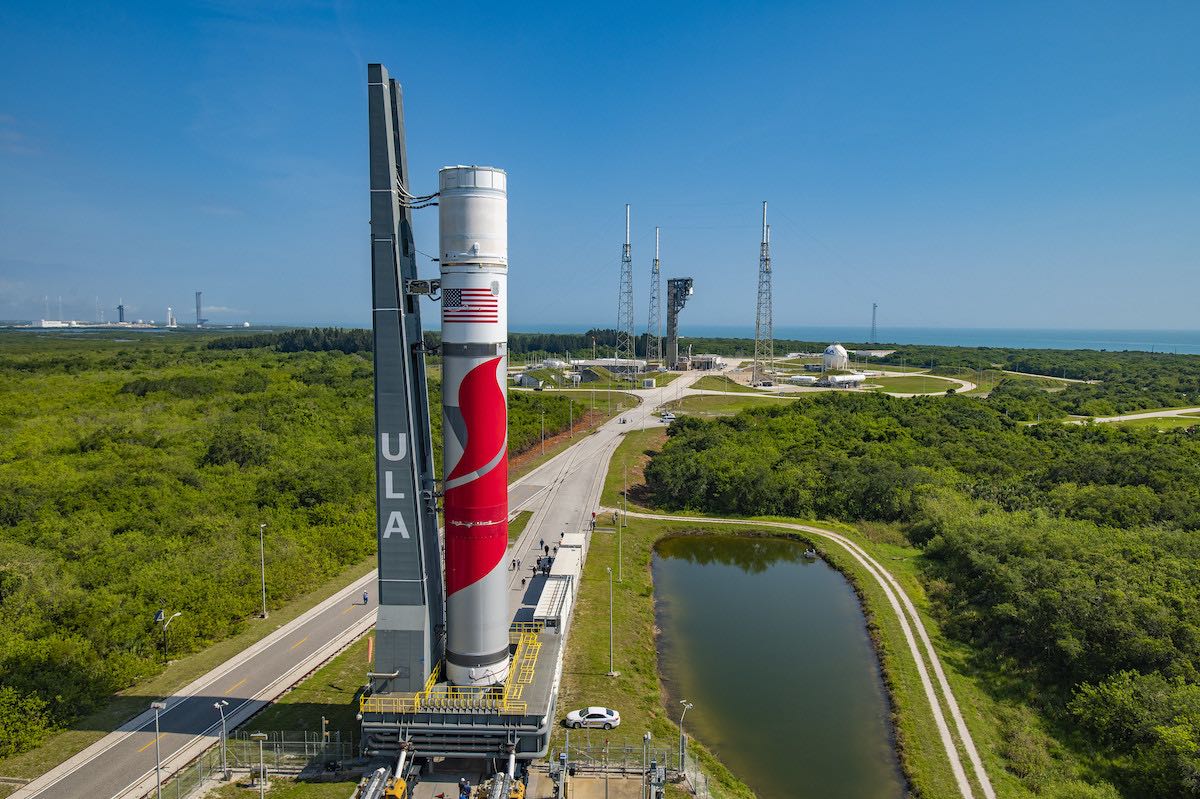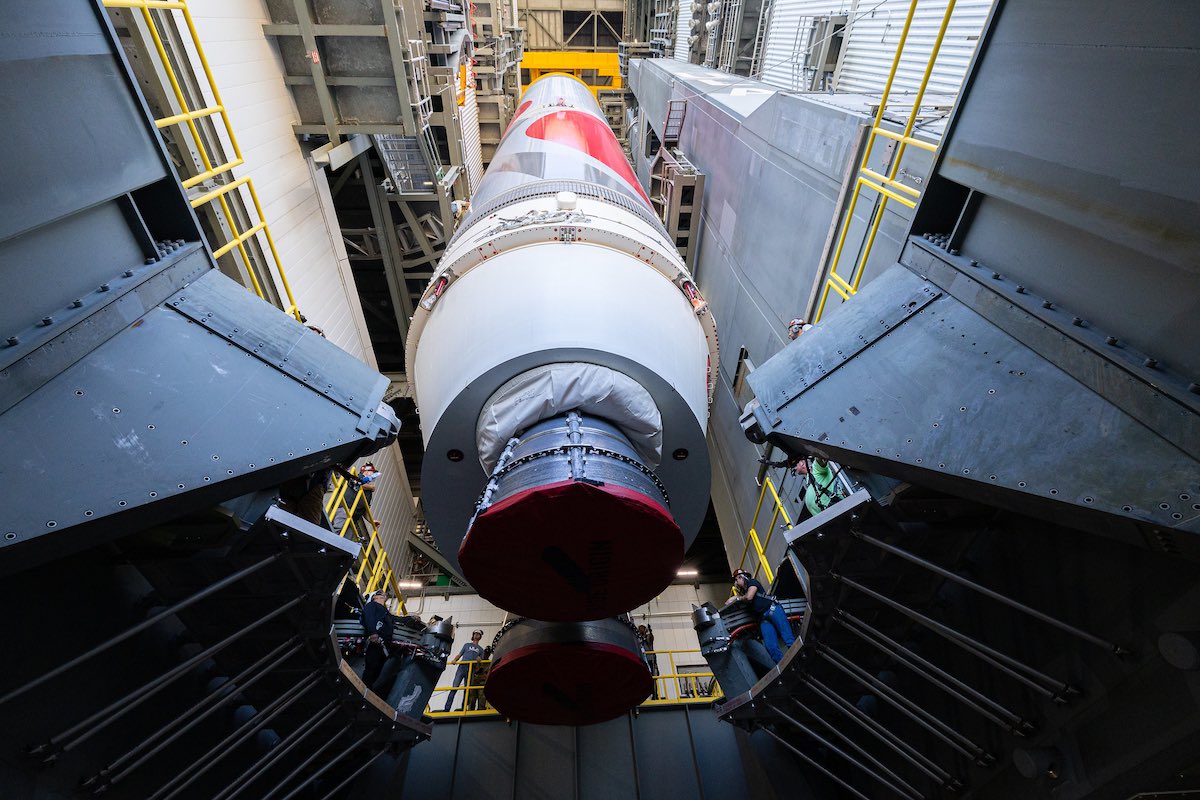
United Launch Alliance’s first Vulcan rocket was filled with methane and liquid oxygen propellants at Cape Canaveral last week for a tanking test, but managers decided to move the rocket back inside a hangar for a few adjustments before proceeding with an engine test-firing.
The Flight Readiness Tanking Test, or FTT, on May 12 was a precursor to the Vulcan rocket’s Flight Readiness Firing, a planned six-second ignition of the launcher’s two Blue Origin-built BE-4 main engines. That test, previously scheduled as soon as Monday, will be delayed at least a few days.
The tanking test and test-firing follow a series of propellant loading demonstrations on the Vulcan rocket in March. ULA delivered the Vulcan first stage and Centaur upper stage to Cape Canaveral in January for the inaugural Vulcan launch. The launch company completed pathfinder testing on a Vulcan test article at Cape Canaveral in 2021.
The Vulcan rocket will replace ULA’s Atlas and Delta rocket families, which have their roots in the early years of space exploration more than 60 years ago. ULA is a 50-50 joint venture between Lockheed Martin and Boeing, which merged their Atlas and Delta rocket programs in 2006. The Vulcan rocket will fly in several configurations, with varying numbers of strap-on solid rocket boosters and different payload fairing sizes available on each flight, depending on mission requirements.
A ULA spokesperson said the company’s engineers “collected excellent data” during the May 12 tanking test, which mimicked a launch countdown with holds, readiness polls, and other milestones.
“Based on the test, there are several parameters that will be adjusted prior to conducting the Flight Readiness Firing,” the ULA spokesperson said in a statement. “We are rolling back to the Vertical Integration Facility, where our access is better and the vehicle is protected to isolate and perform those adjustments.”
Riding a mobile launch platform, the Vulcan rocket rolled off the launch pad and back into the Vertical Integration Facility, or VIF, on Monday, a journey on rail tracks stretching about a third of a mile. The same hangar and launch pad are used by ULA’s Atlas 5 rocket, but the company built a new launch platform specifically designed for Vulcan.
Tory Bruno, ULA’s chief executive, said engineers will adjust a setting associated with ground hydraulic pressure, change the topping rate for liquid oxygen, and adjust the flow of purge and chill gases to the BE-4 engine igniters. “All normal stuff,” Bruno said, adding that the tanking test May 12 was intended to uncover such issues.

The Vulcan rocket sports a colorful paint job with a bright red flame emblazoned on the side of the 17.7-foot-side (5.4-meter) first stage. For the tanking tests and the Flight Readiness Firing, the Vulcan rocket is not fitted with any solid rocket boosters or a payload fairing. Once the test-firing is complete, ULA will install two of the Northrop Grumman-built solid-fueled boosters and the payload shroud supplied by Beyond Gravity, formerly known as Ruag Space.
The Vulcan rocket’s inaugural flight will be the first first launch to use new methane-fueled BE-4 engines from Blue Origin, founded by billionaire Jeff Bezos. At full throttle, each BE-4 engine can generate about 550,000 pounds of thrust. Two of them will power each Vulcan core stage, with zero, two, four, or six solid rocket boosters to add thrust in the first couple of minutes of flight.
The Vulcan rocket’s Centaur upper stage, called the Centaur 5, is an upgrade to the upper stages currently flying on ULA’s Atlas 5 rocket. The Centaur 5 has a wider diameter to accommodate larger cryogenic hydrogen and oxygen propellant tanks, along with two Aerojet Rocketdyne RL10 engines. The Centaur flying on the Atlas 5 rocket typically flies with a single engine.
Once all of the Vulcan rocket configurations are operational, the new rocket will fully replace and grow the lift capability currently offered by all of ULA’s rockets. The largest Vulcan rocket variant, with a single core stage, will have more payload lift capability than ULA’s Delta 4-Heavy, which has three liquid-fueled first stage boosters connected together.
Eventually, ULA plans to recover the reuse BE-4 engines from Vulcan launches, but not the entire first stage.
ULA unveiled the Vulcan rocket in 2015, then targeting a first launch of the new vehicle in 2019. The company selected Blue Origin’s BE-4 engine for the first stage propulsion system in 2018. At that time, ULA aimed to launch the first Vulcan test flight in 2020.
But delays, primarily caused by issues discovered in BE-4 engine production and testing, forced the first Vulcan test flight to slip several years.
Outside of the test rig/ stand. Test article is inside (you can’t see it). Hydrogen leak. H2 accumulated inside the rig. Found an ignition source. Burned fast. Over pressure caved in our forward dome and damaged the rig. pic.twitter.com/0d0KpI1ggj
— Tory Bruno (@torybruno) April 13, 2023
Now the main technical roadblocks before ULA clears the Vulcan rocket for launch are the Flight Readiness Firing and an investigation into an explosive blast during a ground structural test of a Centaur 5 upper stage test article in March. ULA says the “anomaly” was caused by a hydrogen leak, causing the flammable fuel to accumulate inside the test rig before it ignited.
The blast damaged the test stand and caved in the forward dome of the Centaur test article, according to Bruno. ULA has not said whether the hydrogen leak originated on the test stand or inside the Centaur upper stage itself.
With a successful Flight Readiness Firing and completion of the probe into the Centaur test explosion, Bruno said ULA is “protecting” for the possibility of launching the Vulcan test flight this summer.
The Vulcan rocket will launch a commercial moon lander developed by Astrobotic, which will attempt to deliver a batch of NASA experiments and tech demo payloads to the lunar surface. The Astrobotic lander, named Peregrine, is part of NASA’s Commercial Lunar Payload Services Program, which buys rides to the moon for agency payloads on commercially-owned spacecraft.
Two prototype satellites for Amazon’s Kuiper broadband network will also be aboard the first Vulcan launch.
ULA’s Vulcan rocket has been selected by the U.S. Space Force to launch the majority of the military’s large national security satellites for the next five years. The military requires to “certification flights” of the Vulcan rocket before it is approved for national security launch missions.
Email the author.
Follow Stephen Clark on Twitter: @StephenClark1.
from Spaceflight Now https://ift.tt/oed30Lh
via World Space Info







0 comments:
Post a Comment